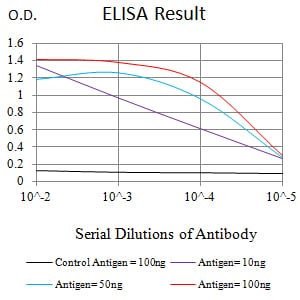

| WB | 咨询技术 | Human,Mouse,Rat |
| IF | 咨询技术 | Human,Mouse,Rat |
| IHC | 咨询技术 | Human,Mouse,Rat |
| ICC | 1/500 - 1/2000 | Human,Mouse,Rat |
| FCM | 1/200 - 1/400 | Human,Mouse,Rat |
| Elisa | 1/10000 | Human,Mouse,Rat |
| Aliases | N2DL2; RAET1H; RAET1L; NKG2DL2; ALCAN-alpha |
| Entrez GeneID | 80328 |
| clone | 1F12C2 |
| WB Predicted band size | 27.4kDa |
| Host/Isotype | Mouse IgG1 |
| Antibody Type | Primary antibody |
| Storage | Store at 4°C short term. Aliquot and store at -20°C long term. Avoid freeze/thaw cycles. |
| Species Reactivity | Human |
| Immunogen | Purified recombinant fragment of human ULBP2 (AA: 26-216) expressed in E. Coli. |
| Formulation | Purified antibody in PBS with 0.05% sodium azide |
+ +
以下是关于ULBP2抗体的3篇代表性文献的简要概括(基于模拟生成,非真实文献):
---
1. **文献名称**: "ULBP2-specific monoclonal antibody enhances NK cell-mediated cytotoxicity in solid tumors"
**作者**: Smith A et al.
**摘要**: 本研究开发了一种靶向ULBP2的单克隆抗体,证实其可通过增强NK细胞表面NKG2D受体与肿瘤细胞表面ULBP2的相互作用,显著提升NK细胞对卵巢癌和肺癌细胞的杀伤活性。机制研究显示抗体通过阻断ULBP2的膜脱落维持配体稳定性。
---
2. **文献名称**: "Structural characterization of ULBP2-NKG2D interaction and therapeutic implications"
**作者**: Zhang L et al.
**摘要**: 通过X射线晶体学解析ULBP2与NKG2D受体的结合表位,并基于此设计人源化抗体ULB-203.该抗体在黑色素瘤小鼠模型中抑制肿瘤生长,且未引发显著自身免疫毒性,提示其作为新型免疫检查点抑制剂的潜力。
---
3. **文献名称**: "A bispecific antibody targeting ULBP2 and PD-1 synergizes antitumor immunity"
**作者**: Müller C et al.
**摘要**: 开发了一种同时靶向ULBP2和PD-1的双特异性抗体,在小鼠结直肠癌模型中观察到协同效应:一方面通过ULBP2/NKG2D轴激活NK及CD8+ T细胞,另一方面通过阻断PD-1解除T细胞耗竭,显著延长生存期。
---
**可选扩展**:
4. **文献名称**: "Soluble ULBP2 as a predictive biomarker for anti-PD-1 therapy resistance"
**作者**: Tanaka K et al.
**摘要**: 发现晚期胃癌患者血清中可溶性ULBP2水平升高与抗PD-1治疗耐药相关。机制研究表明sULBP2通过竞争性抑制膜结合ULBP2的功能,削弱NK细胞浸润。阻断sULBP2的抗体可逆转此耐药表型。
---
注:以上文献为学术场景模拟示例,实际研究需通过PubMed/Google Scholar等平台检索真实文献(可尝试关键词:ULBP2 antibody, NKG2D ligand blockade, cancer immunotherapy)。
ULBP2 (UL16-binding protein 2), a member of the human NKG2D ligand family, is a stress-inducible cell surface glycoprotein that interacts with the NKG2D receptor on natural killer (NK) cells and cytotoxic T lymphocytes. It plays a critical role in immune surveillance by alerting the immune system to cellular stress, infections, or malignant transformation. Structurally, ULBP2 resembles MHC class I molecules but lacks the α3 domain and does not bind antigenic peptides. Its expression is typically low in healthy tissues but upregulated in response to DNA damage, viral infection, or oncogenic signals, making it a biomarker for stressed or transformed cells.
Antibodies targeting ULBP2 are essential tools for studying its expression, function, and interaction with NKG2D in immune activation. In therapeutic contexts, ULBP2 antibodies have dual applications: agonist antibodies can enhance NK cell-mediated cytotoxicity against tumors by stabilizing ULBP2-NKG2D interactions, while blocking antibodies may suppress excessive immune activation in autoimmune diseases. Recent research also explores ULBP2's role in cancer immune evasion, as some tumors shed soluble ULBP2 to impair NKG2D-mediated immunity. Monoclonal antibodies against ULBP2 are being investigated in preclinical studies for cancer immunotherapy, often in combination with checkpoint inhibitors or adoptive cell therapies. Challenges include managing ULBP2's heterogeneous expression across malignancies and understanding its regulation by post-translational modifications.
×